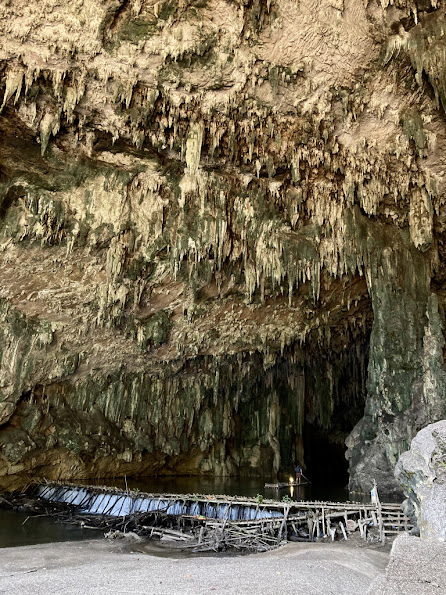In the Northwest corner of Thailand, about five hours' drive north of Chiang Mai, there is a land of dramatic limestone karst mountains. At the invitation of archaeologist Rasmi Shoocongdej, I visited several of the caves a couple of weeks ago.
This is one of the most amazing places I've ever been, with exciting (and confusing) cultural, religious, linguistic, and culinary intersections. It begins with the geology--crazy steep mountains covered in dramatic broadleaf forests.
Nope - I didn't inherit the Asian selfie gene. Still, this gives an idea of the incredible landscapes of NW Thailand.
The Spirit World Above-ground
Until recently, if you wished to stay in the village of Tham Lod you had to hike in about 4.5 miles from the highway. Many hill tribes have migrated from Yunnan, or Myanmar, in recent years and were living traditionally without cars or electricity until the 1980s.
As part of the Long Long Rak Cave research project, the archaeology team is also learning about the relationships of local communities to the caves and the ancient remains deep within.
We visited the villages of Shan, Black Lahu, Red Lahu, and Karen communities. Tiny, twisting roads coil up and down the limestone mountains around hair-raising turns with breathtaking views. I was piled in the back of the pickup with the students, and to get to our destinations we bounced along choking on fine red dust.
We visited a small Karen village, renowned for its weaving traditions. I bought a beautiful piece, dyed with mango leaf extract, from this young lady.
The Buddhist religion in this area has flavors of Thailand, China, India, Cambodia, and Myanmar. Our team did not know the identity or story of this mysterious forest sculpture.
Spectacular male mer-serpents guard a large golden Buddha at a hilltop wat (temple).
The Spirit World Underground
The mountains are full of caves, and each cave has its spirit. The really big caves, like Tham Nam Lod, are filled with them. Once a year the local Shan villagers have a big feast for the spirits but it's wise to pray anytime you enter; lots of things can happen in caves!
We stopped to admire a spectacular stalagtite pillar more than 61 m. tall. Yes, meters (multiply by 3.3 to get ft...)
At the north end of Tham Lod cave, you can climb up near the roof and look down at the bamboo rafts below. The local people are expert rafters, but I still was glad this was the dry season and the water was calm.
Beauty of Tham Lod. Every morning, the bats come in and the swallows go out; and at night, the pattern is reversed.
People are dwarfed by the majesty of this cave.
So...if you are looking to offer a little food to the cave spirits (a good idea), what might they enjoy? This being Thailand, you might think it would be the highly spiced and subtle cuisine this country is famous for!
Lunch at Pa Nui restaurant about 15 minutes' walk from Tham Lod cave entrance. Roasted chicken, Pad Thai, pork with onions and chiles, and (my favorite) two kinds of green papaya salad. Tangy, spicy, refreshing!
Spirit Foods
Yet that's not the case. The local shamans recently changed from animal sacrifice (chickens and pigs in the past) to a kinder, gentler menu: bananas, oranges, soda pop, and sticky rice. The local sticky rice is scrumptious, and can be flavored with cane sugar, sesame seeds, and other delicacies. Khao Lam are a nice spin on this recipe: the rice and flavorings are stuffed into bamboo sections, sealed, and steamed.
This is the ultimate hiking food and much appreciated by the elderly folks who used to walk many miles for trading and religious pilgrimages. You eat khao lam by peeling, as above. The flavor is clean, sweet, a little nutty. These treats can stay fresh and edible in tropical heat for at least a week.
All in all, this journey opened my eyes to a part of Thailand that is rich in cultural heritage old and new. I made some amazing friends, too!
The Long Long Rak Project Team, Tham Nam Lod Forest Preserve, Feb. 8, 2023.





















